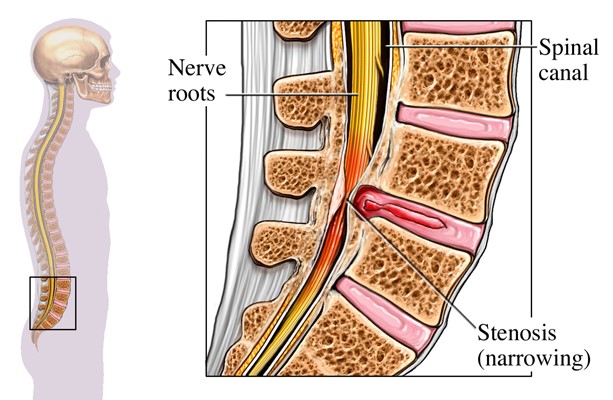The warm weather is here, so let’s get active and get the whole family outdoors , but why aren’t grandma and grandpa joining us? The answer could be Lumbar Spinal Stenosis.
What is it, and why should you care? You may not be in this age group yet, but you likely have a parent, grandparent, aunt, uncle or neighbour that is suffering from Lumbar Spinal Stenos (LSS). You may not see them suffering because the condition as it advances reduces and limits activities, family interactions, social events, and daily household activities, and self care.
You and I have probably thought, “Oh well, Grandpa is getting older. I hope that is not me down the road.” Health issues can run in the family. If you take care of your spine when you are young you can avoid some problems when you are old. Prevention is the majority of the work I do in practice. How many times have we seen some older adults, walking hunched over, “looking down at their shoes or the sidewalk”, shuffling or unsteady gait, perhaps a cane and stopping to sit at every bench available for relief. This is what Lumbar Spinal Stenosis looks like.
Spinal stenosis is a leading cause of pain, disability and loss of independence in older adults typically over the age of 65. It’s usually caused by age-related arthritic narrowing of the spinal canals where nerves exit the spine travelling to the lower back and legs.
Spinal stenosis also occurs in one of two areas: most often it’s in the lumbar bones of the lower back, but around one in four cases involve the cervical vertebrae of the neck. As for the thoracic vertebrae in the middle, they’re usually too stuck in place by the rib cage to bother the spinal cord much.
Spinal stenosis can cause a wide variety of symptoms, including:
- Tingling sensations

- Loss of feeling
- Loss of control
- Weakness
- Incontinence
- Persistent pain
- Cramps
- Reduced ability to stand and walk
As a result of these symptoms, the elderly tend to lead a sedentary lifestyle which negatively affects their quality of life and life expectancy.
Decompression surgery to remove the bone and ligaments around the stenosis is an option for patients with severe symptoms but surgical intervention risks increase with age. However, effective treatments for patients with mild and moderate symptoms have not been established.
Treatments for Spinal Stenosis At Active Chiropractic & Wellness Centre, we offer a non-surgical certified care program for spinal stenosis that is quite relieving to spinal stenosis sufferers. At first, we will do a thorough, clinical examination that may include imaging is important to your pain-free recovery of stenosis. The LSS protocols we use in our clinic, were developed by a classmate of mine, Dr. Carlo Ammendolia, and researched at Mount Sinai Hospital in Toronto proving their effectiveness in both short term relief as well as long term benefits.
Bill H., the very first patient I put through the Lumbar Spinal Stenosis Boot Camp program after obtain my Certification, more than quadrupled the distance he could walk without stopping to bend over or sit. Bill and his wife keep active on their farm, the latest project for them is building a deck.
When lumbar spinal stenosis is causing you pain, call Active Chiropractic & Wellness Centre for gentle relief of back pain. Our chiropractic care may definitely be the answer to the question of “how can I manage my pain from spinal stenosis?” for you!
*This article originally appeared in the June 2017 issue of Neighbours of the Old West End magazine
